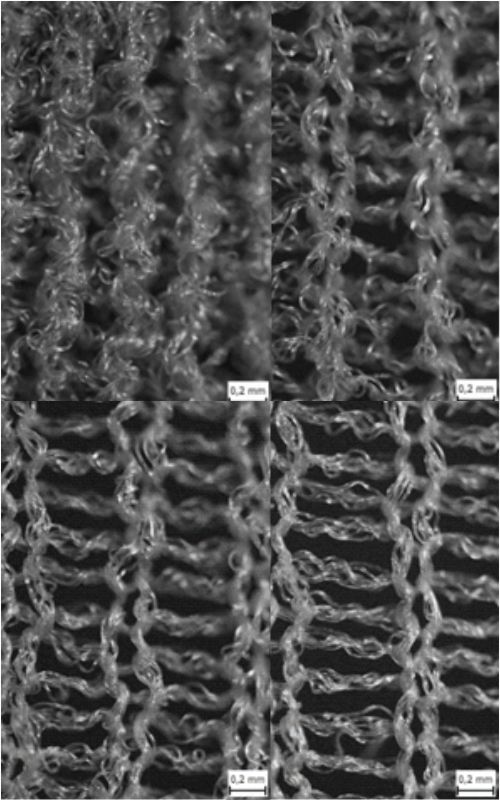P Propustljivost vodene pare najlon ženskih hulahop čarapa Original scientific paper
Glavni sadržaj članka
Apstrakt
Svojstva komfora odeće su jedan od glavnih indikatora udobnosti koji su u poslednjim dekadama bili predmet istraživanja. Ovo istraživanje obrađjuje propustljivost vodene pare ženskih najlon hulahopki, preko ispitivanja ponašanja u relaksiranom stanju, kao i kod istezanja pletenine od 100% (sto odgovara uslovima kod nošenja) i istezanja preko 100% . Za merenje propustljivosti vodene pare korišćena je aparatura Permatest prema standardu ISO 11092. Rezultati pokazuju da za vrlo fine pletenine nema promena u propustljivosti vodene pare kod istezanja, dok za pletenine izradjene od filamenta finoce iznad 44dtex propustljivosti vodene pare opada proporcionalno sa istezanjem
Detalji članka
Broj časopisa
Rubrika

Ovaj rad je pod Creative Commons Aуторство-Nekomercijalno-Bez prerade 4.0 Internacionalna licenca.
Kada je rukopis prihvaćen za objavlјivanje, autori prenose autorska prava na izdavača. U slučaju da rukopis ne bude prihvaćen za štampu u časopisu, autori zadržavaju sva prava.
Na izdavača se prenose sledeća prava na rukopis, uklјučujući i dodatne materijale, i sve delove, izvode ili elemente rukopisa:
- pravo da reprodukuje i distribuira rukopis u štampanom obliku, uklјučujući i štampanje na zahtev;
- pravo na štampanje probnih primeraka, reprint i specijalnih izdanja rukopisa;
- pravo da rukopis prevede na druge jezike;
- pravo da rukopis reprodukuje koristeći fotomehanička ili slična sredstva, uklјučujući, ali ne ograničavajući se na fotokopiranje, i pravo da distribuira ove kopije;
- pravo da rukopis reprodukuje i distribuira elektronski ili optički koristeći sve nosioce podataka ili medija za pohranjivanje, a naročito u mašinski čitlјivoj/digitalizovanoj formi na nosačima podataka kao što su hard disk, CD-ROM, DVD, Blu-ray Disc (BD), mini disk, trake sa podacima, i pravo da reprodukuje i distribuira rukopis sa tih prenosnika podataka;
- pravo da sačuva rukopis u bazama podataka, uklјučujući i onlajn baze podataka, kao i pravo prenosa rukopisa u svim tehničkim sistemima i režimima;
- pravo da rukopis učini dostupnim javnosti ili zatvorenim grupama korisnika na osnovu pojedinačnih zahteva za upotrebu na monitoru ili drugim čitačima (uklјučujući i čitače elektonskih knjiga), i u štampanoj formi za korisnike, bilo putem interneta, onlajn servisa, ili putem internih ili eksternih mreža.
Kako citirati
Funding data
-
International Visegrad Fund
Grant numbers 2017
Reference
Sweeney MM, Branson DH. Sensorial Comfort. Part I: A Psychophysical Method for Assessing Moisture Sensation in Clothing. Text Res J. 1990; 60(7): 371-377. https://doi.org/10.1177/004051759006000701 .
Hes L, de Araujo M. Simulation of the Effect of Air Gaps between the Skin and a Wet Fabric on Resulting Cooling Flow. Text Res J. 2010; 80(14): 1488–1497. https://doi.org/10.1177/0040517510361797.
Bertaux E, Derler S, Rossi R M, Xianyi Z, Koehl L, Ventenat V. Textile, Physiological, and Sensorial Parameters in Sock Comfort. Text Res J. 2010; 80(17): 1803–1810. https://doi.org/10.1177/0040517510369409.
Das B, Das A, Kothari VK, Fanguiero R, de Araújo M. Moisture Transmission Through Textiles Part I: Processes involved in moisture transmission and the factors at play. Autex Res J. 2007; 7(2): 100-110. http://www.autexrj.org/No3-2007/0236.pdf.
Das B, Das A, Kothari VK, Fanguiero R, de Araújo M. Moisture Transmission Through Textiles Part II: Evaluation Methods and Mathematical Modellin. Autex Res. J. 2007; 7(3): 194-216. http://www.autexrj.org/No3-2007/0236.pdf.
Parsons KC.Human thermal environments, Taylor & Francis Publishers, United Kingdom, 1993 https://doi.org/10.1201/b16750.
Sampath MB, Senthilkumar M, Nalankilli G. Effect of filament fineness on comfort characteristics of moisture management finished polyester knitted fabrics. J Ind Tex., 2011; 41(2): 160–173. https://doi.org/10.1177/1528083711400774.
Gericke A, Van der Pol J. A comparative study of regenerated bamboo, cotton and viscose rayon fabrics. Part 1: selected comfort properties. J Fam Ecol Cons Sci. 2010; 38: 63–73. https://www.ajol.info/index.php/jfecs/article/view/61642.
Amber RRV, Wilson CA, Laing RM, Lowe BJ, Niven BE. Thermal and moisture transfer properties of sock fabrics differing in fiber type, yarn, and fabric structure. Text Res J. 2015; 85(12):1269 -1280. https://doi.org/10.1177/0040517514561926.
Bogusławska-Bączek M, Hes L. Effective Water Vapour Permeability of Wet Wool Fabric and Blended Fabrics. Fibres Text East Eur. 2013; 21(1): 67-71. http://www.fibtex.lodz.pl/article844.html.
Ucar N, Yilmaz T. Thermal properties of 1_1, 2_2,3_3 rib knit fabrics. Fibres Text East Eur. 2004; 12(3): 34–38. http://www.fibtex.lodz.pl/archive.htm.
Erdumlu N, Saricam C. Investigating the effect of some fabric parameters on the thermal comfort properties of flat knitted acrylic fabrics for winter wear. Text Res J. 2017; 87(11): 1349–1359. https://doi.org/10.1177/0040517516652347.
Mansoor T, Hes L, Skenderi Z, Siddique H, Hussain H, Javed A. Effect of preheat setting process on heat, mass and air transfer in plain socks. J Text Ins. 2019; 110(2): 159-170. https://doi.org/10.1080/00405000.2018.1523990.





